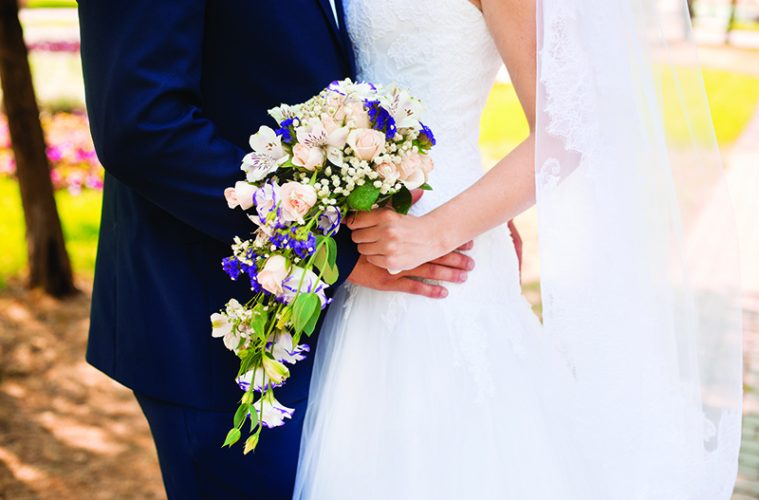Weddings are joyous occasions, but the meeting of friends, family, coworkers, and acquaintances can be a perfect storm for faux pas and etiquette gaffes. Fortunately for couples and wedding-goers, there are a few universally accepted rules to make any couple’s big day run smoothly. Amy McLaughlin of Amy McLaughlin Lifestyles, headquartered in Newburyport, and Andover–based Janie Haas of Janie Haas Events share knowledge gained from years of crafting North Shore weddings.
Etiquette for Guests
Declining or accepting a wedding invitation is the first step, and there’s a proper way to do it. Most couples will include an R.S.V.P. card with the invitation, and guests should respond using this card. McLaughlin recommends adding a personal note, whether you’re declining or accepting: “If you’re declining the invitation, it’s especially important to convey your regrets,” she explains. “Many couples will save R.S.V.P. cards as keepsakes, so even if you’re accepting, writing a short note to the bride and groom is meaningful.” It’s rarely appropriate to R.S.V.P. by phone or email, unless the initial invite was via Paperless Post or a similar service, according to Janie Haas. “Depending on your relationship with the bride and groom, you may want to follow up your R.S.V.P. card with an additional email or phone message,” she adds.
McLaughlin also stresses the importance of accepting or declining an invitation as soon as possible; “Many couples have an ‘A-list,’ of must-have guests and a ‘B-list’ of people to invite if space allows. If guests on the ‘A-list’ decline promptly, the
couple may be able to send their invitation to another guest.” Regardless, both McLaughlin and Haas stress that a gift is expected whether or not you attend the event.
A few rules govern the choosing of gifts. McLaughlin and Haas agree that it is acceptable, at times, to go off-registry, especially if you’re close to the bride and groom. “A good friend of mine knit my daughter a beautiful handmade throw for her wedding,” Haas recounts. “It was incredibly special, and it came from such a heartfelt place.” The amount of money guests spend on the gift can vary widely according to their age and their relationship with the couple, but McLaughlin suggests: “Generally, it’s understood that younger guests may not be able to afford the most expensive gifts; close relatives and friends will often spring for the priciest items off a couple’s registry.” Guests do have a grace period for choosing and sending gifts; anytime within a year of the ceremony is acceptable.
Etiquette for the Bridal Party
In Haas’s opinion, one of the wedding party’s most important duties is to make the engagement period enjoyable for the happy couple, whether this means hosting a bridal shower or bachelor or bachelorette party or going as a group to choose bridesmaid dresses. The bridal party is typically responsible for planning the bridal shower, and Amy McLaughlin suggests that an unrelated maid of honor or bridesmaid should host. “It’s generally poor etiquette for the bride’s family to host the shower,” she explains, “although they may help behind the scenes to plan or pay for the event.”
Etiquette for the Bride and Groom
Once you finalize the guest list, an impeccable seating chart is the next step. Brides and grooms may wonder where to seat themselves; McLaughlin recommends a sweetheart table, for the bride and groom only. “That way the couple won’t need to choose which family members or friends to sit with,” she explains. Alternatively, Haas often creates a large head table for couples, their wedding party, and any plus-ones at the head of the dance floor. As for the rest of the tables, Haas has a rule of thumb: “Try to place at least two couples who know each other at every table. If each person or couple at each table has at least one person they know already, they’ll feel more comfortable.”
Social media has found a place at weddings in recent years. McLaughlin has clients who create wedding hashtags for guests to use on Instagram, Facebook, or Twitter. “If a couple has a wedding hashtag, it’s absolutely appropriate for guests and couples to post photos during the event,” says McLaughlin. Haas typically advises couples to create a wedding website, as well. “It’s a great way to share photos, updates, and information,” she explains.
One place social media has yet to infiltrate is the sending of thank-you notes; both planners insist on hand-written thank-yous. Although a late note is better than no note, it’s ideal to send one within two weeks of the ceremony, according to McLaughlin. “It may be appropriate to pre-empt with a phone call or message, but that doesn’t replace the hand-written card.

